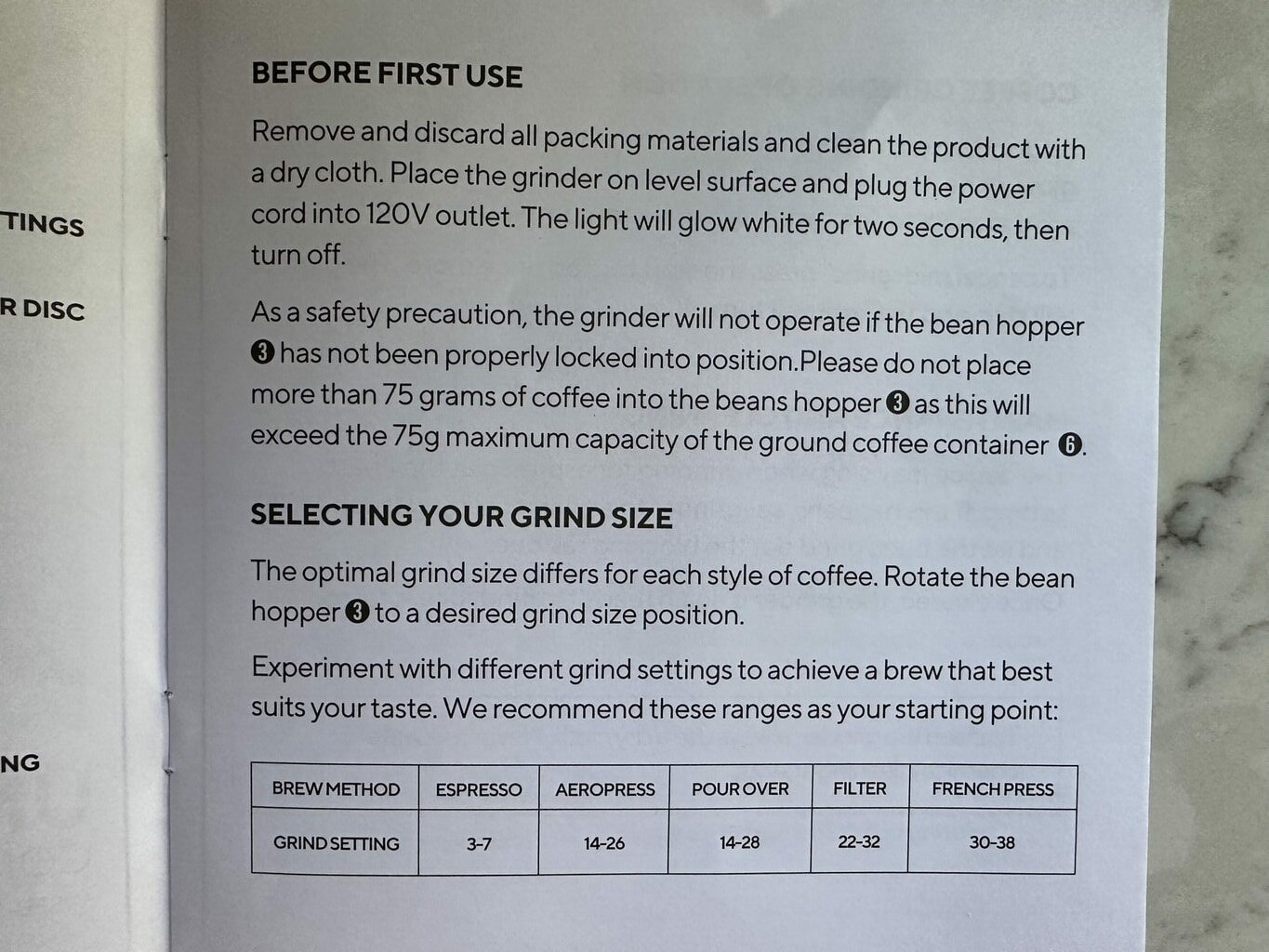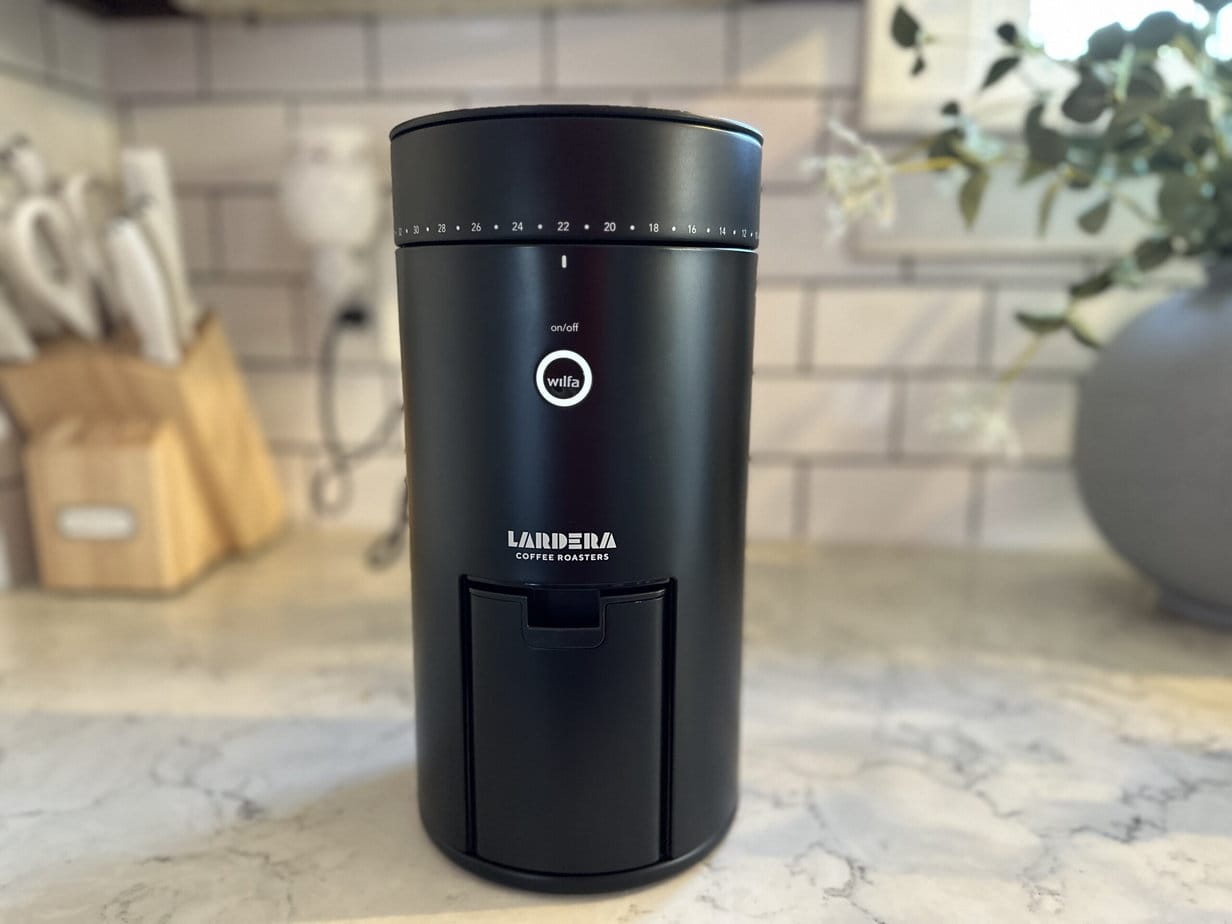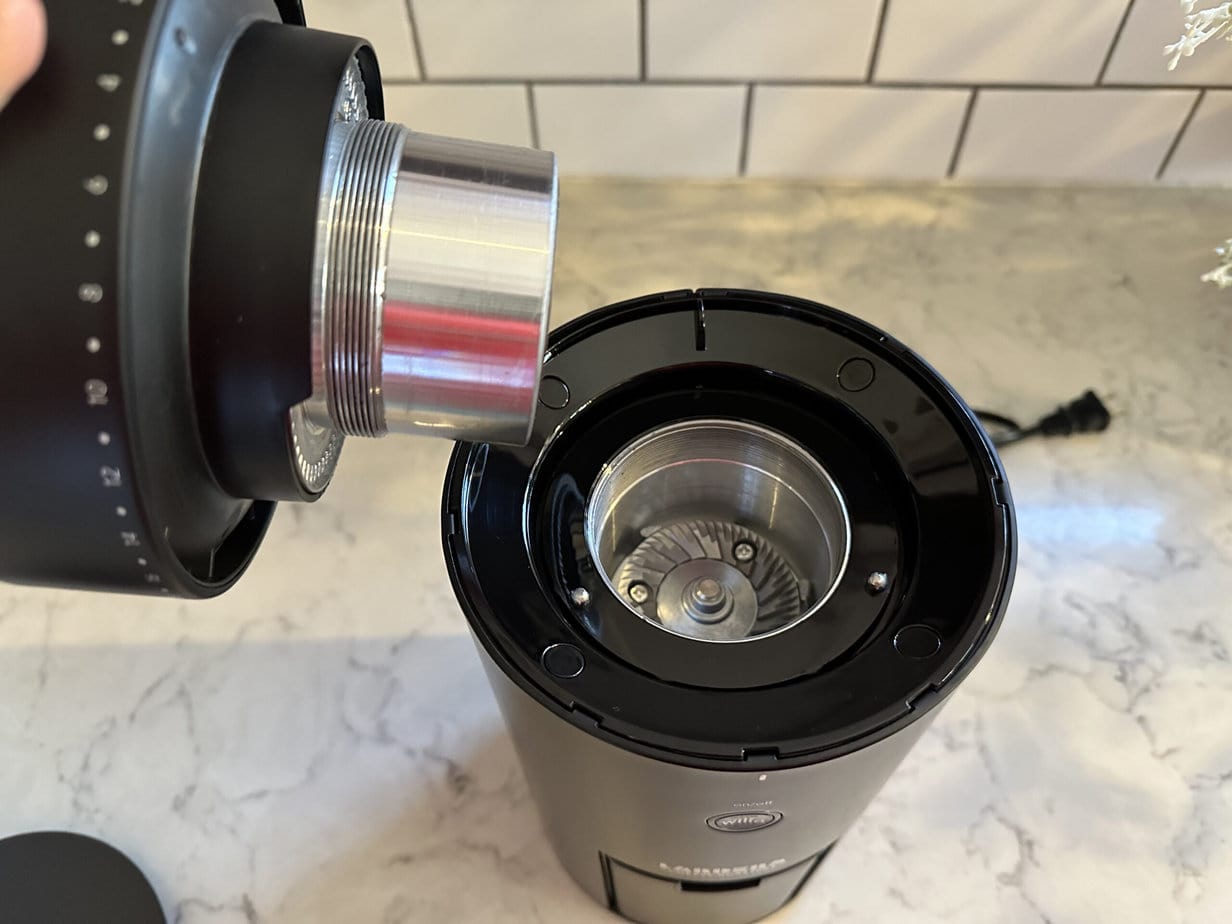We’re not here to judge you if you’re using pre-ground beans in your coffee machine. They’re convenient, usually less expensive than their whole bean counterparts, and capable of producing a decent-tasting cup. Plus, you can choose from a wide range of pre-ground coffees, so you won’t have much trouble finding something you’ll like.
But if you want to take your coffee game beyond “decent-tasting” and into “spectacular” territory, we suggest getting a coffee grinder – like the Wilfa Uniform, for example – and breaking down the beans seconds before brewing them.
The Wilfa Uniform is one of many products at-home baristas can use to get freshly-ground coffee. It has enough grind size settings to accommodate whatever brewer you have on your countertop, and operating it is as simple as pressing a button!
Despite those two positives, the Wilfa Uniform coffee grinder has a few limitations. But whether or not those are minor enough to overlook is something you’ll have to decide for yourself after reading our in-depth review.

About the Wilfa Uniform

Wilfa Uniform Grinder
The Uniform grinder, guided by Tim Wendelboe, produces uniform coffee particles with 41 grind settings, covering espresso to cold brew. Its 58mm Italian-made flat burrs are made from high-quality steel in a stainless-steel body.
The Wilfa Uniform is a collaboration between coffee guru Tim Wendelboe and Norwegian-owned company Wilfa, and is a product that European java lovers have raved over since its 2019 debut.
Wendelboe, an award-winning coffee enthusiast (He won the 2004 World Barista and 2005 World Cup Tasting Championships), and Wilfa get the credit for inventing this gadget. However, we have Lardera Coffee Roasters to thank for bringing it to the States. In spring 2023, the grinder will be available in North America for the first time, exclusively through Lardera.
Roasty was fortunate enough to get our hands on one ahead of its U.S. debut, and we’ll tell you everything we learned from trying it. But first, let’s go over a few things you should know before adding a grinder to your coffee accessory collection.
Things To Consider Before Buying a Coffee Grinder

You can’t just buy the most popular or best-looking coffee grinder, especially if you hope to brew coffee shop-quality coffee. Instead, use the answers to these questions to find the tool that will best meet your needs:
What Kind of Coffee Will You Be Brewing?
Different brewing methods require differently-sized coffee grounds. For example, espresso coffee fans need finely ground beans to make their favorite joe. The medium-fine grind level yields the best results for pour-over users, while French press fanatics must turn the grind adjustment dial to a coarse setting. Those who use an automatic dripper need neither fine nor coarse coffee beans; they’ll need their beans broken down to a medium grind size instead.
That said, make sure a coffee grinder can produce the right grind size for your brewer of choice before you buy it. Doing so is crucial since brewing with the wrong grind size usually won’t work. And if it does, the resulting cup of coffee probably won’t taste very good.
How Much Are You Willing To Spend?
At this point, the coffee grinder market is pretty saturated. Most high-end and inexpensive brands have at least one grinder model in their product lineup. So, your chances of finding something decent in your price range are pretty high.
As you set your budget, don’t assume more expensive machines do the best job, and don’t discount something because it costs less. Some higher-end coffee grinders produce lackluster results, and some cheaper products can break your beans to a perfectly uniform size.
Blades or Burrs?
One component of searching for a reliable coffee grinder is picking between blades and burrs.

Burr grinders have our hearts because they can produce a more uniform grind size than their bladed counterparts. That consistency leads to even extraction during brewing and, in turn, better-tasting and more flavorful cups of coffee.

Unfortunately, the price you pay for burr grinders is usually higher than that of something with blades. That’s why some opt for blade grinders instead. These products may not be able to produce very consistent coffee grounds, but they’re more budget-friendly and get the job done faster.
Manual or Electric?
Some coffee lovers want a machine to do all the work, leaving them with no more responsibility than pressing an on/off button. Others, wanting more control of the process, turn to manual grinders.

Premium hand grinders are usually affordable, capable of producing consistent-sized coffee grounds, portable, durable, and easy to use. Unfortunately, they also require some muscle, take more time to use, and aren’t great for grinding large quantities of coffee.
Those cons lead some java drinkers to electric grinders. You only need enough muscle to press a button or flip a switch; the machine takes care of the rest. Unfortunately, electric grinders can be noisy, difficult to clean, and not easily portable.
Keeping the pros and cons of each in mind, know there’s no right or wrong answer when choosing between manual and electric grinders. Which you’ll like most depends on your needs and which negatives you can live with.
How Much Space Can You Spare?

Shopping for new coffee gear is so exciting that you wish you could throw practicality out the window. But you can’t. No matter how much you love a grinder, it has to be practical. That means making sure you have room to store it.
Before investing in anything, measure your space and check out each product’s dimensions and weight. You don’t want to end up with something too wide, tall, or heavy.
A Quick Overview of the Wilfa Uniform: Pros and Cons
Things We Like
- Quiet compared to other grinders we’ve used
- Feels durable and well-assembled
- Flat burrs are easily accessible
- 5 year warranty
Room for Improvement
- Automatic-off feature isn’t the most accurate
- Not the best for grinding beans for espresso
Roasty’s Wilfa Uniform Coffee Grinder Review

Wilfa Uniform Grinder
The Uniform grinder, guided by Tim Wendelboe, produces uniform coffee particles with 41 grind settings, covering espresso to cold brew. Its 58mm Italian-made flat burrs are made from high-quality steel in a stainless-steel body.
We gave you the short version. Now, let’s dig deeper into the details.
Grind Capability
The Uniform does a lovely job consistently grinding beans, which is good news since that’s its purpose!
We thought the best way to test this machine was by integrating it into our usual brewing routine, so we paired it with a batch of Volcanica beans and our go-to drip brewer, the Ninja DualBrew Pro. We set the machine to grind setting 22 of 41, comparable to but slightly finer than setting seven on the OXO grinder we usually use.
The resulting brew was excellent (shoutout to the even flavor extraction, courtesy of the countertop coffee grinder’s flat burrs – more on those later), but it did take a few seconds longer to grind.

The machine is supposed to run slowly so that the coffee grounds don’t get too hot. We appreciate that effort on Wilfa’s part, but it added a few seconds to the brewing process. That’s not a big deal in the grand scheme of things, but it’s something to be aware of if you live life in a hurry.
Fortunately, the Wilfa Uniform runs more quietly than other grinders we’ve used. So, at least the longer grinding time is unlikely to disturb the other members of your household on an early morning.
Flat Burrs

Wilfa’s Uniform uses 58-millimeter stainless steel flat burrs to break down coffee beans. Flat burrs are good news, and here’s why.
There are two types of burrs, flat and conical, and of the two, flat burrs come out on top. Sure, conical burr grinders produce uniformly-sized results, but they can’t touch the consistency of flat burrs. And – it’s been mentioned before but is worth saying again – same-sized coffee grounds lead to even flavor extraction and delicious coffee.
Filter Coffee Focus
Even though anyone can use the Uniform, Wilfa and Wendelboe designed it with filter coffee geeks in mind.
Filter coffee is just as it sounds: java brewed through a filter. Filter coffee brewing methods, like pour-over and drip machines, rely on gravity to push the hot water through the grounds and filter.
The Wilfa Uniform probably isn’t the grinder for you if you’re mostly doing extremely fine grinds and pulling shots of espresso. That’s not to say you can’t use it to produce the finer grounds you need for espresso with this machine. You can, but truthfully, it’s not the best tool for that.
We haven’t used our grinder to test the finest grind settings just yet, but we did see this note in the user manual:
“When using espresso at the finest setting, the device may stop at some occasions. If this happen, grind coffee with a coarser setting such as #25 and let the burrs grind out the remaining coffee residue that blocks the grinder house. It is then ready for use again.”
We knew from the start that espresso isn’t the Uniform’s forte. So, if it struggles to power through on the finest settings, that wasn’t too big a deal for us, and it probably won’t matter much to an occasional espresso sipper, either.
However, if you start nearly every day with a shot of the strong joe, you probably need a better espresso grinder.
Coffee Bean Hopper & Ground Coffee Container

The Wilfa Uniform is a single-dosing grinder. So, rather than storing your coffee in its bean hopper, you only load the exact amount of beans you’re about to brew into the machine. Speaking of bean hoppers, the one on this grinder can hold 75 grams of coffee. That’s about two ounces. For context, that’s approximately enough joe to brew six cups of regular-strength coffee in an automatic drip machine.*

Wilfa’s grinder collects the ground beans in a bin that fits snugly inside the cylindrical tool. However, the coffee grounds container is irregularly shaped and is prone to getting coffee particles stuck in its crevices.
*Curious about that calculation? Check out Roasty’s coffee-to-water ratio calculator for tips on measuring coffee.
Design & Build

Looks aren’t the most important thing, but we can’t say they don’t matter. After all, what good is a coffee grinder if it throws off your kitchen aesthetic? Fortunately, the Wilfa Uniform’s simple design helps it fit into almost any interior decor setup.
You can tell from the moment you pick the Uniform up that it isn’t a product you’ll want in your travel coffee kit. It’s not that it’s fragile – the grinder’s cast aluminum and steel body wouldn’t get damaged in your carry-on, backpack, or suitcase. However, it weighs around nine pounds, making it too heavy to comfortably tote on your adventures.

The grinder’s heaviness isn’t a bad thing in our book. It gives us the impression that it’s well-built and unlikely to fall apart as a smaller, flimsier product might. Plus, it’s made from durable materials, so expect it to last for years.
Despite its weight, the Wilfa Uniform has a somewhat small footprint, at least as far as width and depth are concerned; it’s 7.6 inches (19.4 centimeters) wide and deep. Height is where things may get sticky. At about 15.6 inches tall, the Uniform towers over several other popular home coffee grinders.
Ease of Use

It isn’t unusual for more expensive coffee gear to be complicated, full of bells, whistles, buttons, and switches. That’s not the case with the Wilfa Uniform, though. There are only two controls: a power button and a grind adjustment dial. Using it is foolproof.

The single button turns the machine on, and you need not worry about pressing it again to turn it off. Instead, a sensor inside the grinder triggers its auto-off function and stops the grinding process without user prompting.
Amazing Warranty
Though we’ve not had to use it, the Wilfa Uniform comes with an impressive 5 year warranty. I’ve always believed that you can tell how a company feels about the performance of their product by the kind of warranty they back it up with.
If this is true, then you can plan on your investment in the Wilfa coffee grinder to be a solid one.
The Uniform+
Don’t confuse the Wilfa Uniform with the brand’s Uniform+. While very similar, one detail distinguishes them: a built-in Bluetooth scale!
You probably won’t notice if your coffee-to-water ratio is off during brewing if you usually take your cup of coffee with sugar, creamer, or flavored syrups. However, a black coffee person will likely be able to tell right away if incorrect measurements ruin the taste of their joe.
A coffee scale is the best means of getting spot-on coffee and water measurements. You can buy one separately or opt for a tool like the Uniform+ that has one integrated into its design.
Adding the scale didn’t change the grinder’s minimalist design, as the good folks at Wilfa built it into the bean hopper lid. And since the scale, which has a rechargeable battery, is accurate to a tenth of a gram, you know your measurements will be precise.
There’s even a built-in timer to help monitor steeping time with brewing methods like the French press or pour-over.
Unfortunately, to our knowledge, Lardera is only bringing the standard Uniform to the U.S.; its scaled sibling will only be available to European Roasty readers.

Wilfa Uniform Grinder
The Uniform grinder, guided by Tim Wendelboe, produces uniform coffee particles with 41 grind settings, covering espresso to cold brew. Its 58mm Italian-made flat burrs are made from high-quality steel in a stainless-steel body.
A Few Alternatives
Overall, we were pleased with the Wilfa Uniform grinder. In our eyes, the pros outweighed the cons.
However, not everyone will deem the Uniform a worthy addition to their morning coffee routine. So, we’ve rounded up a few alternatives we think are worth checking out instead.
Baratza Virtuoso+
Our detailed product breakdown and review may have already introduced you to Baratza’s Virtuoso+. But in case you haven’t gotten around to reading it yet, here are a few key points to note about the grinder as you compare it to the Wilfa Uniform:
- It breaks beans down with conical burrs; Wilfa’s product uses flat burrs.
- The Baratza Virtuoso+ has a smaller footprint than the Uniform. It weighs eight pounds (around three kilograms) and measures about four inches (12 centimeters) wide, 13.7 inches (35 centimeters) tall, and approximately six inches (16 centimeters) deep.
- Baratza’s grinder is the lower-priced option. The cost difference isn’t very significant in the grand scheme of things. However, every penny counts when it comes to your budget.
Fellow Ode Brew Grinder
The Fellow Ode Brew is another worthy contender for someone who wants to invest in a grinder but isn’t in love with Wilfa’s Uniform.
Much like the Scandinavian coffee grinder, Fellow’s model has flat burrs, which means a consistent grind size, even extraction during brewing, and great-tasting java. It’s also filter-focused, designed to master the medium-coarse grind size range. They even cost about the same amount!
Despite these similarities, there are some differences between the two small appliances:
- Fellow’s Ode has fewer grind adjustment settings — 31 versus the Uniform’s 41 — and doesn’t have the range to produce finer grinds for espresso.
- The Ode Brew is shorter than the Uniform, measuring close to 10 inches tall. However, it has more depth — almost 10 inches compared to the Uniform’s 7.6 — and a shorter width; the Uniform is 7.6 inches wide, while the Ode Brew is only 4.2 inches wide.
The Verdict
Overall, we’re fans of the Wilfa Uniform. It does its job and provides excellent grind consistency for filter coffee. Given its price point, we wish it had the range for top-notch espresso grinds, too, but regardless, we like it.
The Uniform is a good buy if you’re looking for a high-quality, filter-focused grinder and can swing the expense. But if you’re exclusively an espresso brewer, find something designed to do fine grinds well instead.
Happy Caffeinating!
Our Wilfa Coffee Grinder Review – The Pros and Cons

Here's our Wilfa Coffee Grinder Review - We check out the technical specs, design, pros and cons, and we suggest a couple of alternatives!
4.5









